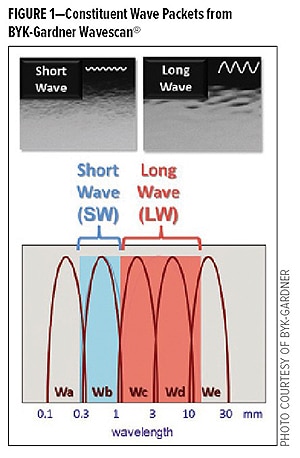Achieving Class A appearance over fiber-reinforced substrates can be challenging. Learn about solutions and the evolving measurements used to characterize topcoated surface appearance.
By D.H. Campbell, BASF Corporation; G. Singh, Magna International; Prasanna Kondapalli, BASF Corporation; Cindy Peters, Ford Motor Company; and Jacob Dumbleton, Nissan North America
Achieving Class A appearance over fiber-reinforced substrates can be challenging. We discuss the evolving measurements used to characterize topcoated surface appearance. The influence of carbon fiber on the surface appearance of a thermoplastic resin-transfer-molding (RTM) substrate is related to differences in thermal expansion within the substrate.
The mechanism identified here is then extended to several chopped-fiber-filled thermoplastic substrates where the fiber-mapping effect is manifested in a different manner. We then investigate the influence of thick-film applications to the Class A surface on appearance. Our analysis finds that both the depth and the width or wavelength of the substrate affect the ability of the thick films to cover fiber mapping.
INTRODUCTION
Fiber-reinforced exterior automotive body panels are receiving increased interest due to light-weighting activities in the automotive industry. In addition to meeting their requirements for stiffness, weight, and cost, exterior automotive body panels must also be capable of providing excellent appearance as a painted part. This is often referred to as “Class A appearance” within the industry, and it is a requirement that proves to be a challenge.
CLASS A APPEARANCE DEFINED AND MEASURED
 Class A appearance is a visible test that requires that the surface of the panel after painting be smooth and free from defects. The smoothness is now measured instrumentally to define the smoothness more precisely. The requirement to be free of defects is still evaluated visually.
Class A appearance is a visible test that requires that the surface of the panel after painting be smooth and free from defects. The smoothness is now measured instrumentally to define the smoothness more precisely. The requirement to be free of defects is still evaluated visually.
A good example where the fiber-reinforced substrate has influenced paint defects is sheet-molding compound (SMC). Fiber protrusion and porosity in SMC panels have long been known to cause solvent and air release during the baking of the topcoat, which results in small boiling defects. Such parts could not be sold, and SMC coating processes frequently had rejection rates of 20-40% due to this defect alone.1 Another common defect is de-wetting or cratering due to mold-release agents2. These defects and their solutions are better understood, so this article will not address these further.
The smoothness requirement is always assessed via the light reflected from the surface after the topcoating. Visually, the observer will judge the quality of the images reflected from the surface. These reflected images are distorted by any waviness or diffuse reflection from the surface. Many factors can influence surface waviness, including both the quality of the substrate and the coating itself. Due to this complexity, the waviness itself is usually composed of many wavelengths superimposed upon one another. Fortunately, we now have instruments such as the BYK Wavescan® that can measure the complex reflected-wave pattern and deconvolute this into its constituent wave packets of varying amplitudes.
Although the Wavescan uses visible light reflection from the surface, the wavelengths reported refer to those of the coating surface structure and not to those of the electromagnetic radiation that is reflected. This concept is represented in Figure 1 where the individual wave packets Wa-We are shown along with their corresponding wavelengths.
CONTINUE READING IN THE JUNE 2021 ISSUE OF COATINGSTECH
References
- Kia, Hamid G.; Shah, Bhavesh; Wathen, Terrence J.; Mitchell, Harry A.; Berger, Christina R. Powder Priming of SMC, Journal of Composite Materials. 2006, vol. 40, no. 16, 1413-1429.
- Florio, John; Miller, Daniel. Handbook of Coating Additives; Marcel Dekker: New York, 2004; p 328.
- Neitzel, M.; Blinzler, M.; Edelmann, K.; Hoecker, F. Polymer Composites. 2000, vol. 21, no. 4, 630-635.
- Noordegraaf, D. A.; Nuss, R. Lightweight High Stiffness Composites Having a Class A Surface Finish, WO2009 147633 A1.
- Beyl, N. Carbon fiber-polyurethane composites produces class A finish, Plastics Today, Oct 16, 2013.
- Warta, H.; Faerber, P. Fiber-Reinforced Shaped Articles with Painted Surfaces and Process for their Production, EP2643394 B1.
COATINGSTECH JUNE 2021 | Vol. 18, no. 6
